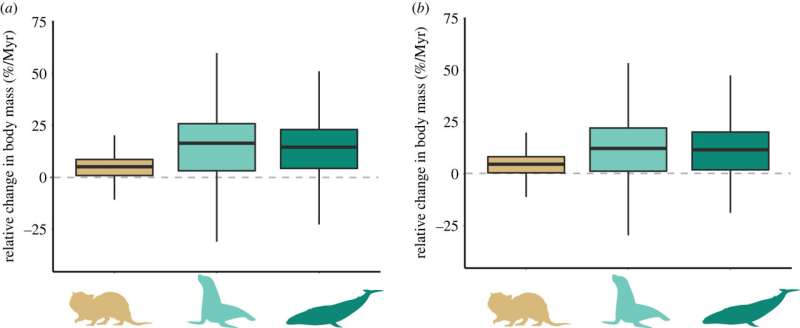Relative change in body mass per Myr, indicating increase in body mass in semi-aquatic and fully aquatic mammals: (a) without hyperprior on µ0; (b) adding hyperprior on µ0. Colored silhouettes represent the aquatic categories: A1, A2 and A3, respectively. Credit: Proceedings of the Royal Society B: Biological Sciences (2023). DOI: 10.1098/rspb.2023.1099
A trio of biologists and environmental scientists, two with the University of Fribourg and the third with the Swiss Institute of Bioinformatics, has found that fully aquatic mammals, such as whales and porpoises, are very unlikely to evolve back into land animals. In their study, reported in Proceedings of the Royal Society B, B. M. Farina, S. Faurby and D. Silvestro conducted phylogenetic analyses of more than 5,000 mammalian species.
Prior research has shown that life began in the water and matured in the ocean. Then, between 350 and 400 million years ago, some creatures began to use their fins to move around on land. Over time, these appendages changed to better suit a life on land, eventually allowing some creatures to become fully terrestrial. But then something odd happened approximately 250 million years ago. Some of those land creatures began venturing back into the sea, and over time, evolved the means to live there. In this new effort, the researchers wondered if it might be possible for species that returned to the sea to ever evolve back to land animals.
The work involved dividing thousands of species into four main mammal groups; those that live only on land, land animals with some aquatic abilities, marine animals with some terrestrial abilities, and those that live only in the sea. The team then analyzed the relationships between species on different branches that had common ancestry. By comparing their traits, they were able to see that the probability of any of the fully marine creatures evolving to live on the land was nearly zero.
Taking a closer look, the researchers found that there appears to be a threshold that, once passed, prevents a marine species from evolving back into a terrestrial species. They note that when land animals take to the sea, they undergo significant physical changes, such as an increase in size, which helps to retain heat in the cold water. They also note that most creatures that returned to the sea became carnivores. The study included only mammals; thus, differences might exist for other types of creatures.
More information: B. M. Farina et al, Dollo meets Bergmann: morphological evolution in secondary aquatic mammals, Proceedings of the Royal Society B: Biological Sciences (2023). DOI: 10.1098/rspb.2023.1099
Journal information: Proceedings of the Royal Society B
© 2023 Science X Network
























